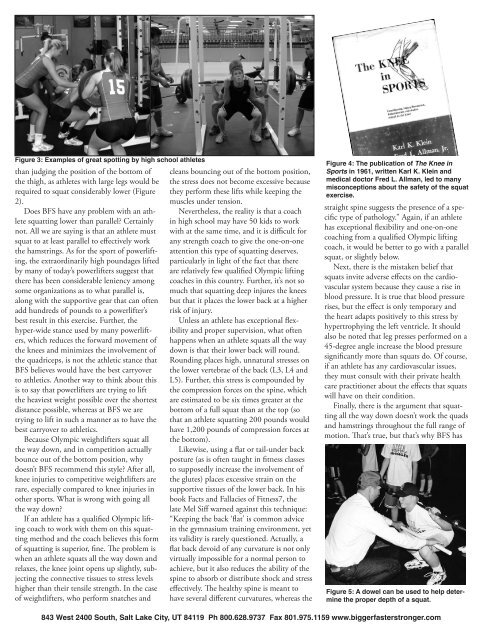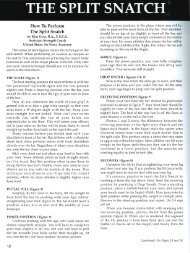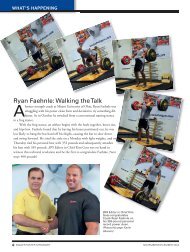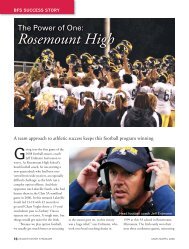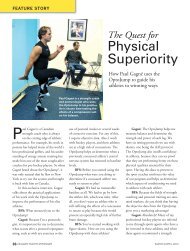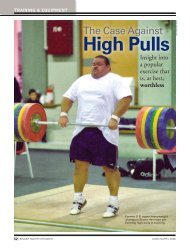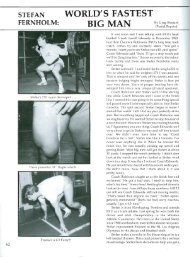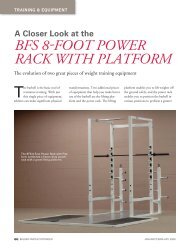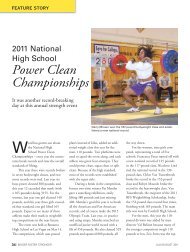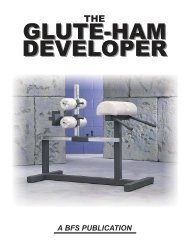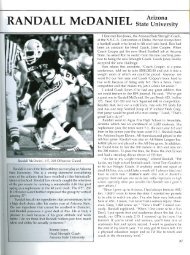POSITION PAPER • The Parrallel Squat - Bigger Faster Stronger
POSITION PAPER • The Parrallel Squat - Bigger Faster Stronger
POSITION PAPER • The Parrallel Squat - Bigger Faster Stronger
You also want an ePaper? Increase the reach of your titles
YUMPU automatically turns print PDFs into web optimized ePapers that Google loves.
Figure 3: Examples of great spotting by high school athletes<br />
than judging the position of the bottom of<br />
the thigh, as athletes with large legs would be<br />
required to squat considerably lower (Figure<br />
2).<br />
Does BFS have any problem with an athlete<br />
squatting lower than parallel? Certainly<br />
not. All we are saying is that an athlete must<br />
squat to at least parallel to effectively work<br />
the hamstrings. As for the sport of powerlifting,<br />
the extraordinarily high poundages lifted<br />
by many of today’s powerlifters suggest that<br />
there has been considerable leniency among<br />
some organizations as to what parallel is,<br />
along with the supportive gear that can often<br />
add hundreds of pounds to a powerlifter’s<br />
best result in this exercise. Further, the<br />
hyper-wide stance used by many powerlifters,<br />
which reduces the forward movement of<br />
the knees and minimizes the involvement of<br />
the quadriceps, is not the athletic stance that<br />
BFS believes would have the best carryover<br />
to athletics. Another way to think about this<br />
is to say that powerlifters are trying to lift<br />
the heaviest weight possible over the shortest<br />
distance possible, whereas at BFS we are<br />
trying to lift in such a manner as to have the<br />
best carryover to athletics.<br />
Because Olympic weightlifters squat all<br />
the way down, and in competition actually<br />
bounce out of the bottom position, why<br />
doesn’t BFS recommend this style? After all,<br />
knee injuries to competitive weightlifters are<br />
rare, especially compared to knee injuries in<br />
other sports. What is wrong with going all<br />
the way down?<br />
If an athlete has a qualified Olympic lifting<br />
coach to work with them on this squatting<br />
method and the coach believes this form<br />
of squatting is superior, fine. <strong>The</strong> problem is<br />
when an athlete squats all the way down and<br />
relaxes, the knee joint opens up slightly, subjecting<br />
the connective tissues to stress levels<br />
higher than their tensile strength. In the case<br />
of weightlifters, who perform snatches and<br />
cleans bouncing out of the bottom position,<br />
the stress does not become excessive because<br />
they perform these lifts while keeping the<br />
muscles under tension.<br />
Nevertheless, the reality is that a coach<br />
in high school may have 50 kids to work<br />
with at the same time, and it is difficult for<br />
any strength coach to give the one-on-one<br />
attention this type of squatting deserves,<br />
particularly in light of the fact that there<br />
are relatively few qualified Olympic lifting<br />
coaches in this country. Further, it’s not so<br />
much that squatting deep injures the knees<br />
but that it places the lower back at a higher<br />
risk of injury.<br />
Unless an athlete has exceptional flexibility<br />
and proper supervision, what often<br />
happens when an athlete squats all the way<br />
down is that their lower back will round.<br />
Rounding places high, unnatural stresses on<br />
the lower vertebrae of the back (L3, L4 and<br />
L5). Further, this stress is compounded by<br />
the compression forces on the spine, which<br />
are estimated to be six times greater at the<br />
bottom of a full squat than at the top (so<br />
that an athlete squatting 200 pounds would<br />
have 1,200 pounds of compression forces at<br />
the bottom).<br />
Likewise, using a flat or tail-under back<br />
posture (as is often taught in fitness classes<br />
to supposedly increase the involvement of<br />
the glutes) places excessive strain on the<br />
supportive tissues of the lower back. In his<br />
book Facts and Fallacies of Fitness7, the<br />
late Mel Siff warned against this technique:<br />
“Keeping the back ‘flat’ is common advice<br />
in the gymnasium training environment, yet<br />
its validity is rarely questioned. Actually, a<br />
flat back devoid of any curvature is not only<br />
virtually impossible for a normal person to<br />
achieve, but it also reduces the ability of the<br />
spine to absorb or distribute shock and stress<br />
effectively. <strong>The</strong> healthy spine is meant to<br />
have several different curvatures, whereas the<br />
Figure 4: <strong>The</strong> publication of <strong>The</strong> Knee in<br />
Sports in 1961, written Karl K. Klein and<br />
medical doctor Fred L. Allman, led to many<br />
misconceptions about the safety of the squat<br />
exercise.<br />
straight spine suggests the presence of a specific<br />
type of pathology.” Again, if an athlete<br />
has exceptional flexibility and one-on-one<br />
coaching from a qualified Olympic lifting<br />
coach, it would be better to go with a parallel<br />
squat, or slightly below.<br />
Next, there is the mistaken belief that<br />
squats invite adverse effects on the cardiovascular<br />
system because they cause a rise in<br />
blood pressure. It is true that blood pressure<br />
rises, but the effect is only temporary and<br />
the heart adapts positively to this stress by<br />
hypertrophying the left ventricle. It should<br />
also be noted that leg presses performed on a<br />
45-degree angle increase the blood pressure<br />
significantly more than squats do. Of course,<br />
if an athlete has any cardiovascular issues,<br />
they must consult with their private health<br />
care practitioner about the effects that squats<br />
will have on their condition.<br />
Finally, there is the argument that squatting<br />
all the way down doesn’t work the quads<br />
and hamstrings throughout the full range of<br />
motion. That’s true, but that’s why BFS has<br />
Figure 5: A dowel can be used to help determine<br />
the proper depth of a squat.<br />
843 West 2400 South, Salt Lake City, UT 84119 Ph 800.628.9737 Fax 801.975.1159 www.biggerfasterstronger.com


